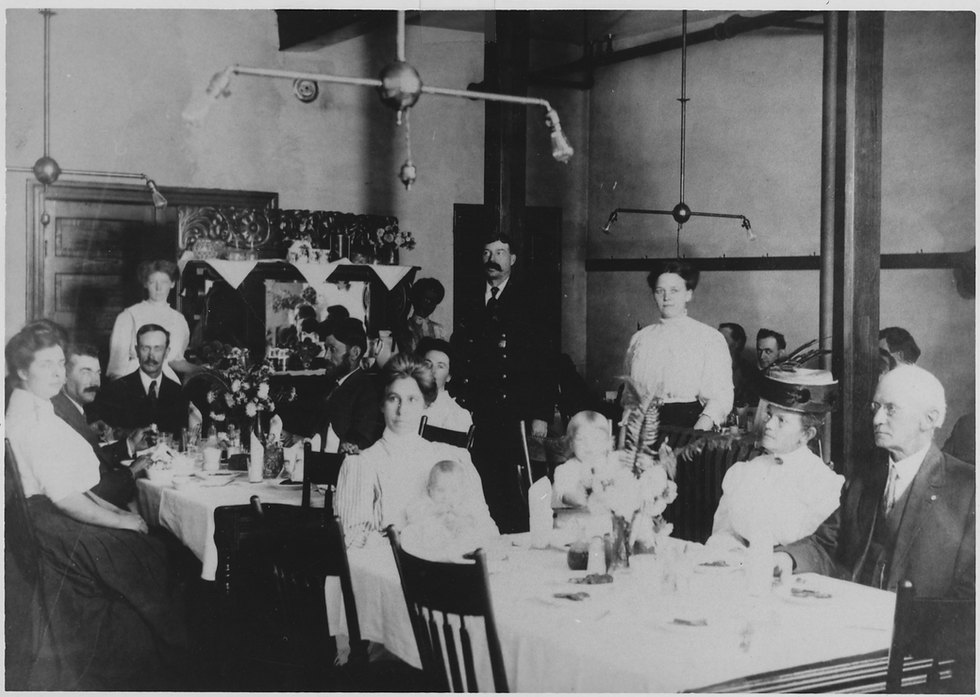Meet You By The Big Rock
- Buzz Anderson
- Feb 23, 2000
- 4 min read
The “Big Rock” at 48th Ave. S and S. Ferdinand St. was once the meeting place of Valley Residents.

This Photo of the Big Rock, with an accompanying article about The Pioneers of Columbia City was published in Paul Alexander’s Rainier District Times in 1966. The above photo and the article are from the archives of the Rainier Valley Historical Society’s Columbia Pioneers Collection.
The article was written to call attention to the Pioneer’s forth-coming 75th annual meeting. The content of the article was not so much about the Big Rock as it was about the recollections of the Pioneers when they gathered for their annual meeting. There were several of the old timers still living at that time who could remember those early days and would tell and retell the stories that, along with the 700 plus photos they had collected, became the foundation for our extensive collection of Rainier Valley history.
The article was written by Ruth Hall who came out from the east to live with her aunt and uncle, the Hipkins, when she was nine years old. The Hipkins had settled in Columbia when Mr. Hipkins, or “Pa Hip” as he was called, was hired as the blacksmith and master mechanic for the streetcar line when it started.
Ruth was raised in that pioneer environment and was fascinated with the area’s history. She became very active in the Columbia Pioneers and served as their historian and secretary for many years right up to the time of her death.
I knew Ruth very well and I can say without a doubt she, along with Carey Summers, were responsible for collecting and preserving the historic collection we inherited from the Columbia Pioneers.
Ruth was obsessed with the preservation of our photos. She arranged for and insisted that the photos be kept in their metal trunk in the vault of the Seattle First National Bank in Columbia City and few people got a chance to see them, even at our annual meetings. If someone wanted to see one of the photos she had to know why, who they were and she would be right beside them watching their every move.
Carey Summers of course was the one who cataloged everything over the years, made negatives and slides and entered the printed material and photo descriptions into his early day computer.
Following is the Rainier District Times article written by Ruth prior to the annual meeting scheduled for Friday evening, April 1st, 1966. I have added some explanations in places, in brackets [ ], to clarify the location or the meaning.
The Columbia Pioneers organization met,[had their first meetings] in homes from 1891 until 1896 when the Columbia Cong’l Church was built and they could meet there. Later around 1910 they met for a few years at Fraternity Hall which was located on Ferdinand St., back of Rainier Floor Covering. [South West corner of Rainier and Ferdinand St.]. At the 1909 meeting Mr. H. H. .A. Hastings delivered a speech over a “Gramaphone”, the new modern invention of the year. Mrs. Hastings, our only living Pioneer of 1891 when the first lots were sold, will be present with us again on April 1st.
Dunlap was awarded a new school in 1899 and soon Brighton and Hillman districts began to grow. Members on the School Board usually lived in Columbia and were brought into close contact with these districts and their people thus bringing in many new memberships to the Columbia Pioneers. It resulted in the Pioneers adding the word of “Vicinity” to their name. [They became “The Pioneers of Columbia City and Vicinity].”
By 1914 we were again meeting back at the Columbia Cong’l Church and continued until 1957. At this time the old school bell which was retained by the Pioneers after the destruction of the old school, was placed in a showcase at Columbia School to be kept as a permanent historical souvenir and an important memento at our future meetings. Any Pioneer can remember how this bell rang out calling us to school each day. I can recall the piano playing, accompanied by the beat of the “triangle”, as we marched out of the building at recess, noon and afternoon sessions. If you played ball on the school grounds do you remember the creek in back, and how we had to retrieve said balls from the water on the opposite bank? That property was Dr. Parks veterinary stable with that “horse odor.”
50 years ago, 1916, was the year of the big snow when many of us as children built huge snow houses and there were days of no school. The older groups met at the big rock at 48th S & Ferdinand Street and hopped on a bob sled for a ride down 48th , across the bridge [over Genesee Street] and on down to the edge of Lake Washington where, on the beach, a bon fire was aflame to keep us warm.
These and many other recollections will be retold at our meeting. Won’t you come and join us?”
Editor’s note:
Part of the “Big Rock” can still be seen on the south side of Ferdinand street, on the bank in front of the second house east of 48th Avenue.
The Rainier Valley Historical Society has continued with the tradition of having our annual meetings where such recollections are retold, only now it is by the children and grandchildren of those early pioneers.
We are planning for our 109th consecutive, annual, meeting this year at 11 am on Saturday, May 20th, 2000. The location is the Rainier Valley Cultural Center, where our office and museum are located, at 3515 South Alaska Street. Won’t you come and join us?
Days Gone By
South District Journal 2/23/2000
By Buzz Anderson
.png)



Comments